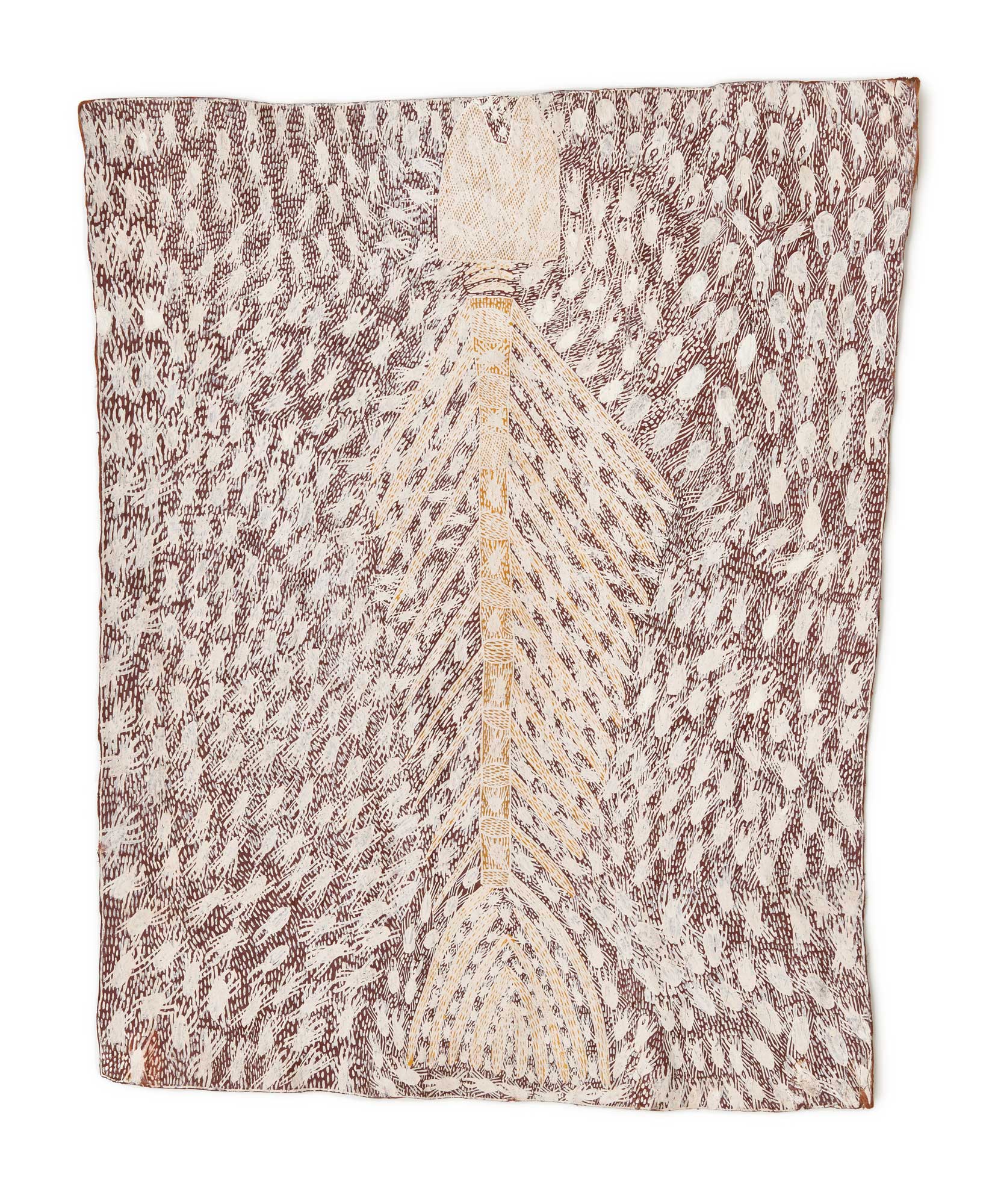
"Muṯimuṯi (2014), is breathtaking in its impact–an extraordinary composition in which the skeleton of the parrot fish takes on almost universal elements of religious iconography. Design, structure and aesthetics combine to give a glimpse of the infinite through the window of mortality. Light seems to emanate from the surface of the painting. To me it is a deeply metaphysical image. As with all great artists Galuma’s paintings stretch the imagination through their creativity and add new dimensions to the viewer’s experience of the world. "
– HOWARD MORPHY
More Info
Maŋgalili country is the site of one of the ceremonial burial ground called the Yiŋapuŋapu. The Yiŋapuŋapu is a low relief sand sculpture designed to keep any contamination of death at bay as traditionally the body of the deceased was placed within it for initial mortuary rites, to cleanse the bones of dangerous spirits held within the body tissue. A metaphor for this action of cleansing is utilized by the Maŋgalili in their sacred paintings by way of depicting sand or ghost crabs picking the bones of a fish carcass on the beach. Contemporary Maŋgalili on the beaches of Djarrakpi put their food scraps in one place when at camp–the secular yiŋupuŋapu. This painting shows the totemic mirriya (crabs) which feeds on the ancestral remains of the parrot fish Yambirrku. The miny’tji or sacred clan design for the sand-scapes of Djarrakpi both adorn and surround the crabs. The smaller crabs are soldier crabs or muṯimuṯi. In traditional mortuary ceremony for this clan the last act is to catch and eat Yambirrku and dispose of the bones in the ceremonial sand sculpture for the crabs to pick clean overnight.
– Buku-Larrŋgay Mulka Centre
Additional Information
Decade
2014
Medium
Natural pigments on eucalyptus bark
Dimensions (IN)
51 31/32 x 41 23/32 x 5 1/8
Dimensions (CM)
132 x 106 x 13
Credit
Kluge-Ruhe Aboriginal Art Collection of the University of Virginia. Purchased with funds provided by Vivien Anderson Gallery, 2021.
Narrative
Maŋgalili
The Maŋgalili clan belongs to the Yirritja moiety. Their major spiritual theme revolves around the...
Songline
Yiŋapuŋapu
The yiŋapuŋapu is a low relief sand sculpture, elliptical in shape, that is used in...
Location
2010s
The 2010s saw Buku-Larrŋgay Mulka go from strength to strength. At the National Aboriginal and...
About The Artist(s)

Clan
Maŋgalili
Artist Dates
1951-2018
Galuma Maymuru
Galuma Maymuru was one of the first women to paint the maḏayin miny’tji (sacred clan designs). She was taught by her father Narritjin Maymuru. Galuma worked as a teacher at Bäniyala School and was influential in the Buwayak movement, in which the figurative elements of paintings were buried beneath more abstract designs. In 2003, she received the bark painting prize at the National Aboriginal and Torres Strait Islander Art Awards.
Collections Represented
Art Gallery of New South Wales
Ballarat Fine Art Gallery
Berndt Museum of Anthropology at the University of Western Australia
Kluge-Ruhe Aboriginal Art Collection of the University of Virginia
Museum and Art Gallery of the Northern Territory
National Museum of Australia
Sydney Opera House

